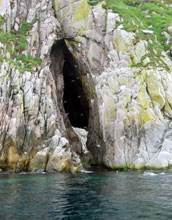Multimedia Gallery
King Island (Image 2)
King Island (Image 2)
The people living in the village of Ugiuvak on King Island, used this cave as year-round refrigeration where meat was stored in the icy interior. [See related image here.]
More about this Image
King Island is located 1 mile west of Alaska (64°58200 3N, 168°05200 3W.) in the Bering Sea. It is about 1.6 kilometers (1 mile) wide. A group of about 200 Inupiat (the Aseuluk) used to call the island their winter home, where they would engage in subsistence hunting. In the summer, they'd live on the mainland near the location of present-day Nome, Alaska. After the establishment of Nome, the islanders began to sell intricate carvings to the residents there during the summer. But by 1970, all King Island people had moved to Nome year-round.
Principal investigator Deanna Kingston of Oregon State University received a grant from the National Science Foundation's Arctic Social Sciences Program (OPP 03-28234), to conduct an in-depth interdisciplinary project on traditional ecological knowledge (TEK) with the community of King Island. The proposed research will document TEK of King Island Inupiat (Eskimo), including research on the cultural geography and biogeography of King Island. This project not only fits into a growing literature on TEK, but also examines social science theory on place names, memory, cultural meaning and geography. In addition, Kingston plans on training young King Island community members, who are by definition from an underrepresented minority group, in social and biological scientific methods of data collection and analysis. In this way, she hopes to stimulate the interest of young Inupiats in scientific careers. (Date of Image: July 18, 2005)
Credit: Claire Alix, Alaska Quaternary Center, University of Alaska, Fairbanks
Images and other media in the National Science Foundation Multimedia Gallery are available for use in print and electronic material by NSF employees, members of the media, university staff, teachers and the general public. All media in the gallery are intended for personal, educational and nonprofit/non-commercial use only.
Images credited to the National Science Foundation, a federal agency, are in the public domain. The images were created by employees of the United States Government as part of their official duties or prepared by contractors as "works for hire" for NSF. You may freely use NSF-credited images and, at your discretion, credit NSF with a "Courtesy: National Science Foundation" notation.
Additional information about general usage can be found in Conditions.
Also Available:
Download the high-resolution JPG version of the image. (2.5 MB)
Use your mouse to right-click (Mac users may need to Ctrl-click) the link above and choose the option that will save the file or target to your computer.



